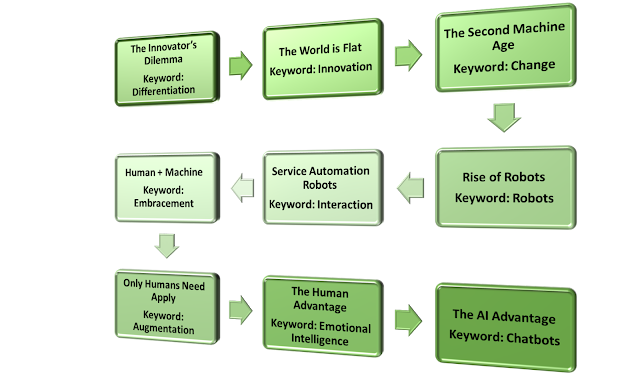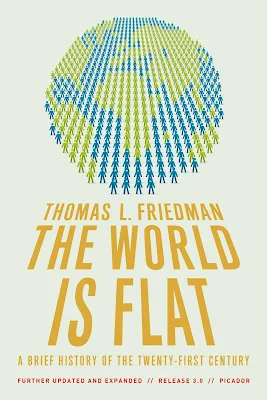Will Machines Replace Humans in the Industry 4.0?
Introduction
Digitization, Digitalization, Digital Transformation, Industrial Revolution
4. What's next?
Where is this disruptive technology taking us? We've seen the industrial
revolution effects on jobs and most of labor-efficient markets are worried
about the 4th industrial revolution or Industry 4.0 that it might take a lot
of market jobs.
Take it or leave it, disruptive technology always creates new jobs much
more than depleted jobs. You might notice certain jobs disappearing but
those jobs are the jobs that transform humans to robots, to machines, and
the technology is creating machines to replace them.
Also, those jobs are mostly task-driven and does not involve any brain
action They just encompass routine and are mainly positioned around
repetitive manufacturing processes.
No need to be afraid of the digital world, although everything is getting
digital. Nowadays, it's not enough for a company to teach its employees
about management skills, finance, accounting, HR and other functional jobs.
The trend is now driven towards customer analysis.
Technology creates the data analysis tools to manipulate and create custom
scenarios using artificial intelligence (AI), Big Data and machine learning
(ML) algorithms to predict and drive consumer behavior. Data analytics
tools, such as Google Analytics, and others are available today for free,
and, if used correctly, can help organizations save millions, maybe billions
of dollars of sales and marketing.
Note: The market is full of data analytics tools, so be careful to chose
the most mature ones that have enough reviews and evaluations from genuine
customers and are from original sources of well-known and well-reputed
companies.
Industry 4.0 Timeline
The below books timeline shows the mindset change throughout history which
led us to the fourth industrial revolution, what is called Industry 4.0.
Each book is reviewed briefly and uses one keyword, in bold, to show the
link with the previous one.
 |
| Industry 4.0 Timeline |
Book 1: The Innovator's Dilemma - When New Technologies Cause Great Firms to Fail
Few decades ago, the key differentiation among organizations was the
innovation. You create an innovative idea for a service or product, you
launch it and start earning your benefits. Innovation helped companies to
stay relevant in the ever-changing business environment.
In this book, Clay Christensen, shows how even the most outstanding
companies can do everything right, yet still lose market share just because
they missed out new waves of innovation and didn't abandon the business
traditional practices.
For more information about innovation, please check my previous post about
the art of innovation
here.
Book 2: The World is Flat - A Brief History of the Twenty-First Century
One of the most important innovations that has changed the work
trend was the fact that the world became flat, offering access to passionate
and qualified talent at much lower cost.
The most affected countries were of course China and India, where the
industrial revolution created economic powerhouses in the manufacturing and
services market.
In this book, Thomas L. Friedman lists stories that will change
your mind about how to see things in a new way. Also, on how to be a
political activist and social entrepreneur where globalization phenomenon is
taking effect. He also highlights the more troubling question of how to
manage our reputations and privacy in a world where we are all becoming
publishers and public figures.
Change initiatives were a must at that time, there was an urge to empower
individuals to lift populations out of poverty and drawbacks.
Book 3: The Second Machine Age: Work, Progress, and Prosperity in a Time of Brilliant Technologies
At this stage, and due to the inevitable inflation expansion, a
change was unavoidable, but this time the change was towards an
evolution in the industrial sector to meet the tremendous increase in
population and technologies.
In this book, the authors Erik Brynjolfsson and Andrew McAfee reveal the
forces driving the reinvention of our lives and our economy. Companies will
be forced to change or die. People will have to adapt to that change as
well, otherwise, they will lose their jobs.
Digital technologies, including hardware, software and networks will have a
better ability than doctors to diagnose accurately diseases by manipulating
available data that only humans could do earlier.
This book also sheds a light on how to revamp the education so that it
prepares the people to the next economy instead of the historical one. Here
is where Industry 4.0 is born and the robots have risen.
Book 4: Rise of the Robots: Technology and the Threat of a Jobless Future
When almost everybody started talking about robots, most of the
industries started raising the risk of losing their employees and replacing
them with machines. At that point specifically, the researchers and
scientists started digging in market studies to evaluate which jobs will be
lost and which will be regained from this disruption.
Robots are more efficient and productive than humans in a lot of repetitive
manufacturing tasks, also much cheaper when it comes to payroll and
expenses.
In this book, Martin Ford explains clearly the dilemma of "who
and what" will remain in the market and "who and what" will leave, in terms
of talent and jobs.
Artificial Intelligence was already on its way to make a lot of jobs as
obsolete; blue collar and white collar workers are at risk and the economy
as a whole was not ready to face the implications and consequences of
technology disruption.
It is very recommended to read this book to understand how the economy
bypassed this situation of loss and how we moved from the fear of losing
manufacturing jobs to the fear of losing service automated jobs.
Book 5: Service Automation Robots and the Future of Work
Robots also started taking place of some jobs in the service industry where
automation started to invade the services that white collars used to
accomplish. Somebody had to jump in and explain the future and where are
robots leading the industry.
Professors Leslie Willcocks and Mary Lacity summarize the
answer of the "1-million $" question: "Will we be needed
anymore?"
Using multiple case studies, surveys, and interviews with service
automation clients, the authors research the market for clear answers about
how humans and robots can interact without replacing each
other.
Which jobs will remain for humans while the AI algorithms are improving
dramatically?
Book 6: Human + Machine - Remaining Work in the Age of AI
Struggling to find a formula that combines humans + machines to accelerate
the economy and beat the Industry 4.0 revolution is the role of brilliant
researchers and scientists.
Paul R. Daugherty and H. James Wilson released this book to
define the key components of this formula and explain how the market evolved
with its two pillars: Humans and Machines.
In order to grow, the economy gurus and researchers could not give away any
of these two factors, so the formula is found and simple: Humans have to
embrace machines and work together with them.
Organizations need to understand how AI is evolving rapidly, they need to
harness AI to surge ahead, otherwise, they will fall behind.
Now, humans and machines started competing together, and a new race is
created between the two challenges for better advantages.
Book 7: Only Humans Need Apply - Winners and Losers in the Age of Smart Machines
Will humans surrender to machines? Humans created those machines so the
answer is ?
AI is penetrating in almost every aspect of our personal life, our jobs and
even our emotions. Humans need to find jobs where they can take advantage of
jobs that machines cannot.
Thomas Hayes Davenport and Julia Kirby restate the
conversation about how machines are deeply integrated with humans, and that
the battle or race is not actually a race. They both have to adapt
together.
They both need to work together, in other terms, humans need to use
technology effectively and efficiently to accelerate and realize
augmentation in better, faster, and smarter ways.
Creativity is required between the two economy pillars and
innovation will be back to distinguish the winning organizations from the
falling ones because innovation is always the winner. The choice is
ours.
Book 8: The Human Advantage - The Future of American Work in an Age of Smart Machines
 |
| The Human Advantage |
If you are interested about how the American market evolved with the race of
humans and machines, you might be interested to read this book. Also, if you
are willing to continue the progress of our post timeline to know if you will
be replace by technology or not, you might need to read this book and the next
one, as they will give you the answer in your perspective like nobody can
answer it better.
In this story-driven manifesto about the American work,
Jay W. Richards gives us the result of such un-ending battle argument,
because it makes us more fragile and dependent on arguing rather than focusing
on integration and success in our evolving economy.
The American work succeeded to create a model for all social levels to thrive
and live with the age of disruption. Richard defines clearly in
this book what was happening in the economy and how real individuals began to
rebuild a new culture of virtue, capitalizing on human skills only, including
but not limited to: creativity, resilience, and empathy. Simply "Emotional Intelligence".
Book 9: The AI Advantage - How to Put the Artificial Intelligence Revolution to Work
 |
| The AI Advantage |
AI growth is inevitable. It will improve our decision making dramatically in
business, medicine, trading, finance, data analysis, product development,
manufacturing processes, and many other invisible tasks.
But, AI won't replace human workers, it will rather augment their capabilities
for them to be both smarter and working together. They create a competitive
advantage when applied correctly in organizational decision making
process.
Thomas H. Davenport offers us a clear guide in this book on how to use
the available technology tools and utilities, to make more efficient
decisions.
Humans should develop their own expertise on top of what AI can report to them
from the automated data analysis when engaging customers and employees with AI
chatbots. Customers or consumers driving the future business by using
AI technologies highlighted in this book, will definitely push organizations
to cooperate with technology.
Multiple stories mentioned in this book will show us how Google and Amazon
have driven the AI market towards perfection and used those technologies to
achieve what they are now doing and leading the market.
Conclusion
When any new technology emerge, it is compared to positive pandemic, and
organizations need not to resist or fight its emergence because it will be too
late to catch up after falling back.
The internet is full of stories of huge organizations who did not realize that
they are falling back like Nokia, BlackBerry, and others.
Quick and effective adaptation to technology change is the key of success for
us, and innovation is the key of differentiation. Organizations need to focus
on ways to integrate together, augment their actions and efforts, towards
achieving success.
Humans and Machines will continue to fight but isn't that fight necessary and
useful for competition?
Competition always create a healthy environment where all parties thrive to
advance and the market will prosper with new creative inventions.








